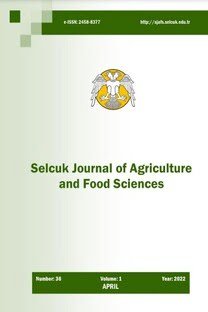Konya yeşil alanlarındaki çimlerde antibiyotik ve biotik kaynaklı kurumaların nedenleri
Fusarium culmorum, Fusarium solani, Rhizoctonia solani, otlaklar, patojenler, Fusarium equiseti, Fusarium oxysporum, Türkiye, abiyotik hasarlar, çayırlar, bitki hastalıkları
The causes of drying originated form abiotik and biotik reasons on turfgrass in the green areas in Konya
Fusarium culmorum, Fusarium solani, Rhizoctonia solani, grasslands, pathogens, Fusarium equiseti, Fusarium oxysporum, Turkey, abiotic injuries, meadows, plant diseases,
___
- Anonymous, 2004b. Pythium Diseases of Turfgrasses. www.ipm.u.uc.edu/diseases/series400/rpd410
- Anonymous, 2005a. http://ohiohlc.tripod.com/ diseas
- Anonymous, 2005b. www.msue.msue.edu/imp/madz
- Anonymous,2005c. ext.nodak.edu/extpubs/plantsci/ landscap/pp950w.htm
- Anonymous,2005d.http://www.umassturf.org/publications/extension-turf-pubs/cult-prac-sample
- Arx, J.A. Von, 1970. The Genera of Fungi Sporulat-ing in Pure Culture, Cramer, Lehre, 288 pp.
- Baldwin, N.A., 1987. Fungal Diseases of Sports Turf. Mycologist 4(81):16-19
- Barnett, H.L. ve B.B., Hunter, 1972. Illustrated Genera of Imperfect Fungi, Third Edition, Burgess Publishing Company, Minnesota, 241 pp.
- Bean, G.A., 1966. Observation on Fusarium Blight of Turfgrasses. Plant Dis. Rep. 50(12):942-945
- Bedford, E.R. ve H.B. Couch, 1964. Fusarium Blight of Turfgrasses Phytopathology 56: 781-786.
- Bloom, J.R. ve H.B. Couch,1960. Influence of Environment on Diseases of Turfgrasses. I.Effect of Nutrition pH and Soil Moisture on Rhizoctonia Brown Patch. Phtopathol.50:532-53
- Brown, G.E., H. Cole ve R.R. Nelson,1972. Pathogenicity of Curvalaria spp. to Turfgrass. Plant Disease Reporter 56(1):59-63
- Butler, E.J. ve S.C. Jones, 1961. Plant Pathology Mo Millan Co. Ltd. London, XII + 1979.
- Couch, H.B., 2000. The Turfgrass Disease Handbook.
- Garling, D.C. ve M.J. Boehm, 2001. Temporal Effects of Compast Topdressing and Inorganic Fertilizer Applications on Nitrojen Fertility of Golf Course Turfgrass. Argon. J.93:548- 555.
- Hodges, C.F., 1972. Interaction of Culture Age and Temperature on Germination and Growth of Curvularia geniculata and Virulance. Can. J. Botany 50: 2093-96. Howard, F.L., 1953. Helminthosporium-Culvularia Blights of Turf and Their Cure. Golf Course Reporter 21(2):5-9.
- Howard, F.L., N.B. Rowell, and H.L.Kell, 1951. Fungus Diseases of Turfgrasses. Agricultural Experiment Station Bulletion No:103, University of Rhode Island, 56 pp.
- Johnson, A. and C. Booth, 1983. Plant Pathologist’s Pocketbook. Second Edition. Commonwealth Mycological Institute, England, p. 439.
- Kacar, B. ve V. Katkat, 1998. Bitki Besleme. Uludağ Üniversitesi, Güçlendirme Vakfı, Yayın No:127, Vipaş Yayınları:3, Bursa.
- Karaca, İ., 1974. Sistematik Bitki Hastalıkları, Deuteromycetes (Fungi Imperfecti). Cilt 4. Ege Üniversitesi Ziraat Fakültesi Yay. No:217-272
- Lewis, G.C., 1989. Factors Influencing The Effects of Fungicide Treatment on Seedling Emergence of Perennial Rye Grass (Lolium perenne) Grass and Forage Science 44:417-422
- Loschinkohnl, C., J.W. Rimelspach ve M.J. Boehm, 1999. The Impact of Compost Soil Amendments on Fungal Diseases of Turfgrass. Phytopathology 89:S46
- Orçun, E., 1969. Özel Bahçe Mimarisi (Çim Sahaları Tesis ve Bakım Tekniği), Ege Ün. Zir. Fak.Yayın No:152, Bornova-İzmir
- Parmeter, J.R., 1970. Rhizoctonia solani, Biology and Pathology. Üniversity of California Press, Berkeley, USA.
- Pirone, P.P., 1978. Diseases and Pests of Ornamental Plants, 5th Ed. New York John Wiley & Sons
- Sanders, P.L., L.L. Burpee ve H.Cole, 1977. Preliminary Studies on Binucleate Turfgrass Pathogens that Resemble Rhizoctonia solani Phytopathology 68:145-148
- Smiley, R.W., H.D. Peter ve B.C. Bruke, 1992. Compendium of Diseases. 2 nd. Ed. American Phytopathological Society, St. Paul, MN.
- Tani, T. ve J.B., Beard 1998. Turfgrass Disaeses. Phytopathology173:47-48
- Turhan G. ve K. Turhan, 1989. Suppression of Damping-off on Pepper Caused by Pythium ultimum Trow and Rhizoctonia solani Kühn by Some New Antagonists in Comparison With Trichoderma harzianum Rifai. J. Phytopathology 123:175-182.
- Uzun, G., 1989. Peyzaj Mimarlığında Çim Ve Spor Alanları Yapımı. Çukurova Ün. Zir. Fak. Yard. Ders Kitabı No:20:149. Adana
- Warcup, J.H., 1958. ‘Distiribution and Detection of Root-Disease Fungi’ Plant Pathology Problems and Progress (Ed). C.S.Hulton, G.W. Fulton, Helen Hart, SEA, Mc Callan The Ragents of the University of Wisconsin, 317-324.
- Wernham, G.C. ve R.S. Kırby, 1941. A New Turf Disease (Abst.) Phytopathology 31.24.
- Yıldız, F., M. Yıldız, ve N. Delen, 1990. The Preliminary Studies on the Turfgrass Diseases in Turkey. The Journal of Turkish Phytopathology 17(3):119
- ISSN: 1300-5774
- Yayın Aralığı: Yılda 3 Sayı
- Başlangıç: 2018
- Yayıncı: Selçuk Üniv. Ziraat Fak.
Yıldız Seher MADAKBAŞ, Meral ERGİN, Hüseyin ÖZÇELIK, Beyhan KÜÇÜKOMUZLU
Konya yeşil alanlarındaki çimlerde antibiyotik ve biotik kaynaklı kurumaların nedenleri
Combining ability and inheritance of some agronomical traits in bread wheat
Konya'da tüketime sunulan süt ve süt ürünlerinin ağır metal içeriklerinin belirlenmesi
Ahmet AYAR, Durmuş SERT, Nihat AKIN
Ekmeklik buğdayda(Triticum aestivum L.) bazı agronomik özelliklerin kombinasyon yeteneği ve kalıtımı
Fasulyenin hasat-harman mekanizasyonunda enerji tüketimleri
Mehmet Hakan SONMETE, Fikret DEMİR
Şanlıurfa ili Harran Ovasında pamuk üretiminin fonksiyonel analizi
Birol ÖZKALP, MUSTAFA ONUR ALADAĞ, YUSUF DURAK
Ankara Haymana-Kızılkoyun göleti havzası temel toprak özellikleri ve sınıflandırılması
